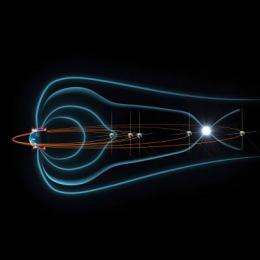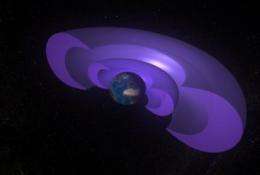THEMIS: 'Singing' electrons help create and destroy 'killer' electrons

Scientists using NASA's fleet of THEMIS spacecraft have discovered how radio waves produced by electrons injected into Earth's near-space environment both generate and remove high-speed "killer" electrons.
Killer electrons are born within Earth's natural radiation belts, called the Van Allen belts after their discoverer, James Van Allen. Killer electrons are mostly found in the outer belt, which over the equator begins approximately 8,000 miles above Earth and tapers off about 28,000 miles high.
The high-speed electrons pose a threat to satellites in or near the outer belt -- those in medium-level and higher (geosynchronous) orbits -- like the Global Positioning System and most communications satellites. They are known as "killer" electrons because they can penetrate a spacecraft's sensitive electronics and cause short circuits.
"This discovery is important to understand the physical processes that shape the radiation belts, so that one day we will be able to predict the moment-by-moment evolution of the radiation belts and be in a position to safeguard satellites in these regions, or astronauts passing through them on the way to the moon or other destinations in the solar system," said Dr. Jacob Bortnik of the University of California, Los Angeles, lead author of a paper on this research appearing May 8 in Science.

Electrons are subatomic particles that carry negative electric charge, and we harness their flow every day as electricity. Electrons are also present in space in a gas of electrically charged particles called plasma, which is constantly blown from the surface of the sun. When this plasma interacts with Earth's magnetic field, some of it is shot toward Earth. The magnetic field over Earth's night side acts like a slingshot, propelling blobs of plasma toward Earth. When this happens, electrons in the plasma blobs release extra energy gained from the slingshot by "singing" - they generate a discrete type of organized radio wave called "chorus," which sounds like birds singing when played through an audio converter.
Scientists previously discovered that electrons in the outer radiation belt can extract energy from these chorus waves to reach near-light speed and become killer electrons. The new research, confirmed by the team's THEMIS (Time History of Events and Macroscale Interactions during Substorms) observations, is that the chorus waves can be refracted into the inner portion of the radiation belts by dense plasma near Earth and bounce around from hemisphere to hemisphere within the radiation belts. When this happens, the chorus waves become disorganized and evolve into another type of radio wave called "hiss," according to the team.
Hiss waves, named for the sound they make when played through a speaker, are of interest to space weather forecasters because earlier research showed they can clear killer electrons from lower altitudes of the outer radiation belt. Hiss deflects the speedy particles into Earth's upper atmosphere, where they lose energy and are absorbed when they hit atoms and molecules there. Despite its important role, it was not clear how hiss was generated.
"It is not immediately obvious that these two waves are related, but we had a fortuitous observation where the THEMIS spacecraft were lined up just right to make the connection," said Bortnik. "First we observed chorus on the THEMIS "E" spacecraft, then a few seconds later, we observed hiss on the THEMIS "D" spacecraft, about 20,000 kilometers (almost 12,500 miles) away, with the same modulation pattern as the chorus."
"Last year, we published a Nature paper that put forward a theory that seemed to explain just about everything we knew about hiss," adds Bortnik. "We showed theoretically how chorus could propagate from a distant region, and essentially evolve into hiss. We reproduced statistical information about hiss, and a few case-examples published in the literature seemed to agree with what we were predicting. The only problem was that it seemed really difficult to verify the theory directly -- to have a satellite in the (distant) chorus source region, to have another satellite in the hiss region, to have both satellites recording in high-resolution simultaneously, for the waves to be active and present at the same time, and for the satellites to be in the right relative configuration to each other to make the measurement possible. That's where THEMIS came in. It has the right set of instruments, and the right configuration at certain parts of its orbit."
According to the team, it's possible other mechanisms could contribute to the generation of hiss as well. "Lightning could certainly contribute, and so could 'in situ' growth - the high-speed particles in the belts could generate hiss with their own motion. However, it's just a question of which mechanism is dominant, and each might dominate at different times and locations. More research is needed to determine this," said Bortnik.
Source: NASA/Goddard Space Flight Center















